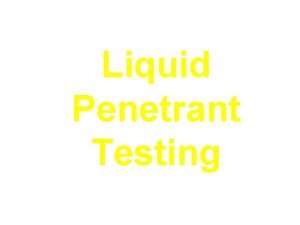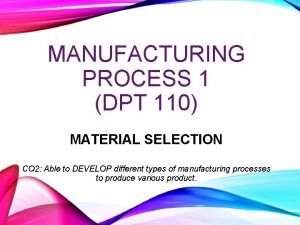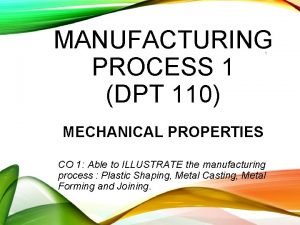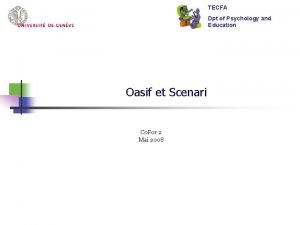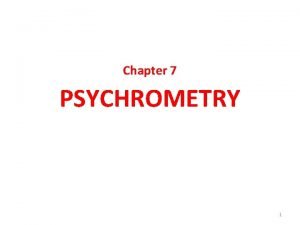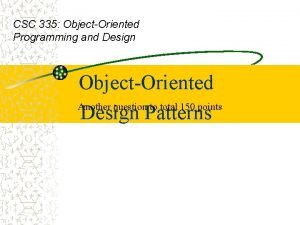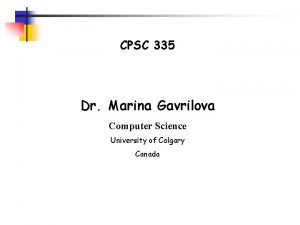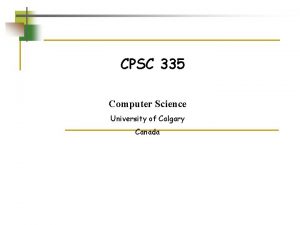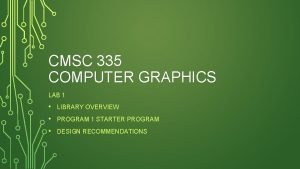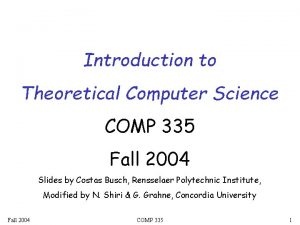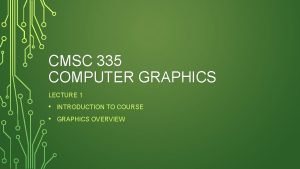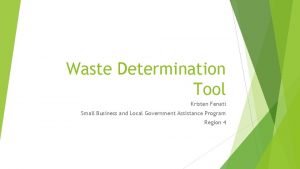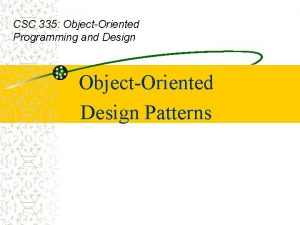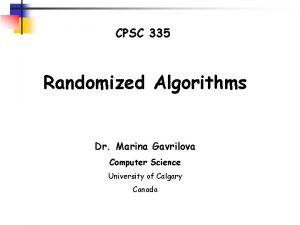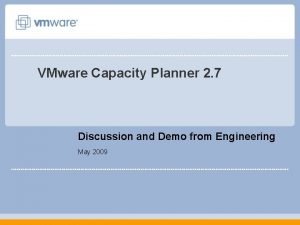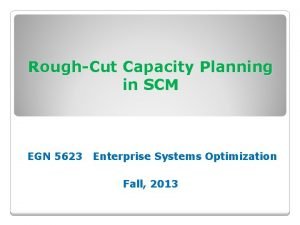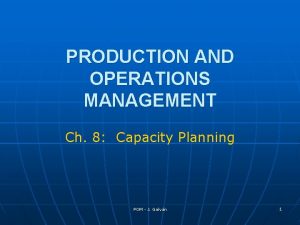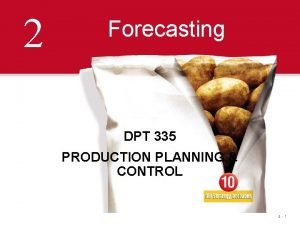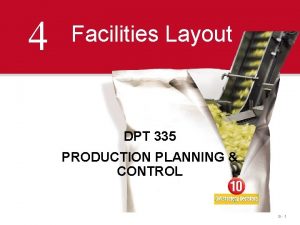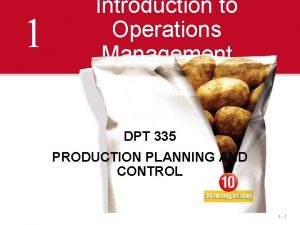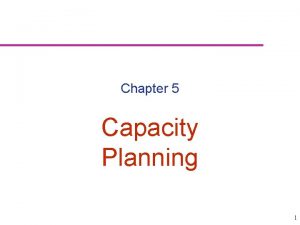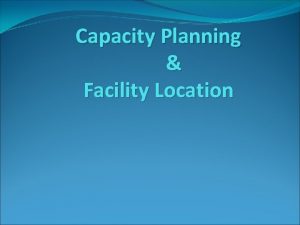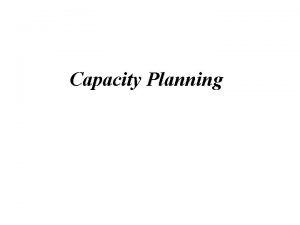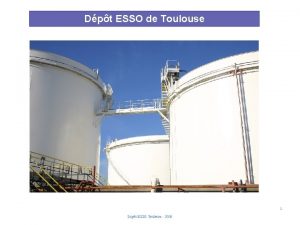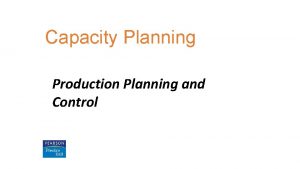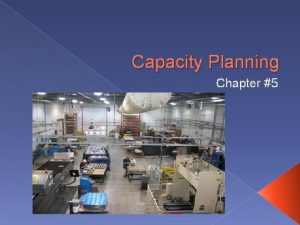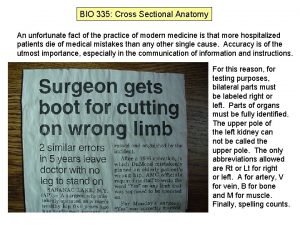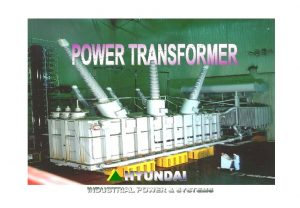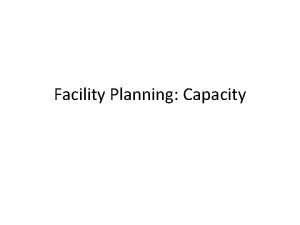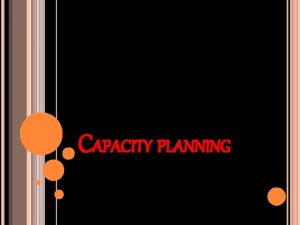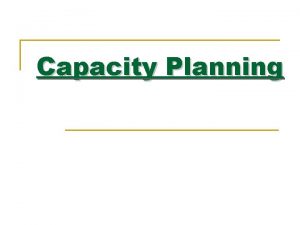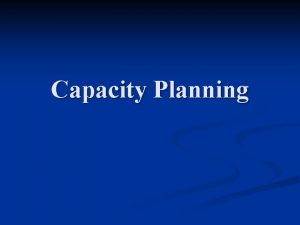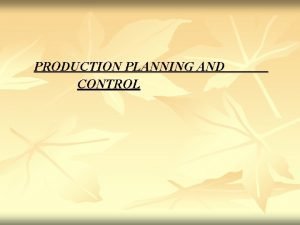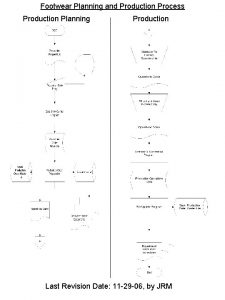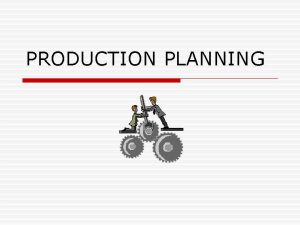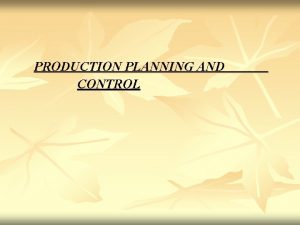Capacity Planning Chapter 3 DPT 335 Production Planning



























- Slides: 27

Capacity Planning Chapter 3 DPT 335 Production Planning & Control S 7 - 1

Process Strategies The objective of a process strategy is to build a production process that meets customer requirements and product specifications within cost and other managerial constraints S 7 - 2

Capacity u The throughput, or the number of units a facility can hold, receive, store, or produce in a period of time u Determines fixed costs u Determines if demand will be satisfied u Three time horizons S 7 - 3

Planning Over a Time Horizon Options for Adjusting Capacity Long-range planning Add facilities Add long lead time equipment Intermediaterange planning Subcontract Add equipment Add shifts Short-range planning * Add personnel Build or use inventory * Schedule jobs Schedule personnel Allocate machinery Modify capacity * Difficult to adjust capacity as limited options exist © 2011 Pearson Education Use capacity Figure S 7. 1 S 7 - 4

Design and Effective Capacity u Design capacity is the maximum theoretical output of a system u Normally expressed as a rate u Effective capacity is the capacity a firm expects to achieve given current operating constraints u Often lower than design capacity © 2011 Pearson Education S 7 - 5

Utilization and Efficiency Utilization is the percent of design capacity achieved Utilization = Actual output/Design capacity Efficiency is the percent of effective capacity achieved Efficiency = Actual output/Effective capacity © 2011 Pearson Education S 7 - 6

Bakery Example Actual production last week = 148, 000 rolls Effective capacity = 175, 000 rolls Design capacity = 1, 200 rolls per hour Bakery operates 7 days/week, 3 - 8 hour shifts Design capacity = (7 x 3 x 8) x (1, 200) = 201, 600 rolls S 7 - 7

Bakery Example Actual production last week = 148, 000 rolls Effective capacity = 175, 000 rolls Design capacity = 1, 200 rolls per hour Bakery operates 7 days/week, 3 - 8 hour shifts Design capacity = (7 x 3 x 8) x (1, 200) = 201, 600 rolls S 7 - 8

Bakery Example Actual production last week = 148, 000 rolls Effective capacity = 175, 000 rolls Design capacity = 1, 200 rolls per hour Bakery operates 7 days/week, 3 - 8 hour shifts Design capacity = (7 x 3 x 8) x (1, 200) = 201, 600 rolls Utilization = 148, 000/201, 600 = 73. 4% S 7 - 9

Bakery Example Actual production last week = 148, 000 rolls Effective capacity = 175, 000 rolls Design capacity = 1, 200 rolls per hour Bakery operates 7 days/week, 3 - 8 hour shifts Design capacity = (7 x 3 x 8) x (1, 200) = 201, 600 rolls Utilization = 148, 000/201, 600 = 73. 4% S 7 - 10

Bakery Example Actual production last week = 148, 000 rolls Effective capacity = 175, 000 rolls Design capacity = 1, 200 rolls per hour Bakery operates 7 days/week, 3 - 8 hour shifts Design capacity = (7 x 3 x 8) x (1, 200) = 201, 600 rolls Utilization = 148, 000/201, 600 = 73. 4% Efficiency = 148, 000/175, 000 = 84. 6% S 7 - 11

Bakery Example Actual production last week = 148, 000 rolls Effective capacity = 175, 000 rolls Design capacity = 1, 200 rolls per hour Bakery operates 7 days/week, 3 - 8 hour shifts Design capacity = (7 x 3 x 8) x (1, 200) = 201, 600 rolls Utilization = 148, 000/201, 600 = 73. 4% Efficiency = 148, 000/175, 000 = 84. 6% S 7 - 12

Bakery Example Actual production last week = 148, 000 rolls Effective capacity = 175, 000 rolls Design capacity = 1, 200 rolls per hour Bakery operates 7 days/week, 3 - 8 hour shifts Efficiency = 84. 6% Efficiency of new line = 75% Expected Output = (Effective Capacity)(Efficiency) = (175, 000)(. 75) = 131, 250 rolls S 7 - 13

Bakery Example Actual production last week = 148, 000 rolls Effective capacity = 175, 000 rolls Design capacity = 1, 200 rolls per hour Bakery operates 7 days/week, 3 - 8 hour shifts Efficiency = 84. 6% Efficiency of new line = 75% Expected Output = (Effective Capacity)(Efficiency) = (175, 000)(. 75) = 131, 250 rolls © 2011 Pearson Education S 7 - 14

Capacity and Strategy u Capacity decisions impact all 10 decisions of operations management as well as other functional areas of the organization u Capacity decisions must be integrated into the organization’s mission and strategy © 2011 Pearson Education S 7 - 15

Capacity Considerations 1. Forecast demand accurately 2. Understand the technology and capacity increments 3. Find the optimum operating level (volume) 4. Build for change © 2011 Pearson Education S 7 - 16

Managing Demand u Demand exceeds capacity u Curtail demand by raising prices, scheduling longer lead time u Long term solution is to increase capacity u Capacity exceeds demand u Stimulate market u Product changes u Adjusting to seasonal demands u Produce products with complementary demand patterns S 7 - 17

Tactics for Matching Capacity to Demand 1. Making staffing changes 2. Adjusting equipment u Purchasing additional machinery u Selling or leasing out existing equipment 3. Improving processes to increase throughput 4. Redesigning products to facilitate more throughput 5. Adding process flexibility to meet changing product preferences 6. Closing facilities © 2011 Pearson Education S 7 - 18

Demand Capacity Management in the Service Sector u Demand management u Appointment, reservations, FCFS rule u Capacity management u Full time, temporary, part-time staff © 2011 Pearson Education S 7 - 19

Bottleneck Analysis and Theory of Constraints u Each work area can have its own unique capacity u Capacity analysis determines the throughput capacity of workstations in a system u A bottleneck is a limiting factor or constraint u A bottleneck has the lowest effective capacity in a system © 2011 Pearson Education S 7 - 20

Process Times for Stations, Systems, and Cycles u The process time of a station is the time to produce a unit at that single workstation u The process time of a system is the time of the longest process in the system … the bottleneck The mig se t wo h t be it u The process cycle time is the time diff qui e te r takes for a product to go throughenthe t! production process with no waiting © 2011 Pearson Education S 7 - 21

A Three-Station Assembly Line A B C 2 min/unit 4 min/unit 3 min/unit Figure S 7. 4 © 2011 Pearson Education S 7 - 22

Process Times for Stations, Systems, and Cycles u The system process time is the process time of the bottleneck after dividing by the number of parallel operations u The system capacity is the inverse of the system process time u The process cycle time is the total time through the longest path in the system © 2011 Pearson Education S 7 - 23

Capacity Analysis u Two identical sandwich lines u Lines have two workers and three operations u All completed sandwiches are wrapped Order 30 sec/sandwich © 2011 Pearson Education Bread Fill Toast 15 sec/sandwich 20 sec/sandwich 40 sec/sandwich Wrap 37. 5 sec/sandwich S 7 - 24

Capacity Analysis Order 30 sec Bread Fill Toast 15 sec 20 sec 40 sec Wrap 37. 5 sec u Toast work station has the longest processing time – 40 seconds u The two lines each deliver a sandwich every 40 seconds so the process time of the combined lines is 40/2 = 20 seconds u At 37. 5 seconds, wrapping and delivery has the longest processing time and is the bottleneck u Capacity per hour is 3, 600 seconds/37. 5 seconds/sandwich = 96 sandwiches per hour u Process cycle time is 30 + 15 + 20 + 40 + 37. 5 = 142. 5 seconds © 2011 Pearson Education S 7 - 25

Capacity Analysis u Standard process for cleaning teeth u Cleaning and examining X-rays can happen simultaneously Cleaning Check in Takes X-ray Develops X-ray 24 min/unit 2 min/unit 4 min/unit X-ray exam Dentist Check out 8 min/unit 6 min/unit 5 min/unit © 2011 Pearson Education S 7 - 26

Capacity Analysis Cleaning Check in Takes X-ray Develops X-ray 24 min/unit 2 min/unit 4 min/unit X-ray exam Dentist Check out 8 min/unit 6 min/unit 5 min/unit u All possible paths must be compared u Cleaning path is 2 + 4 + 24 + 8 + 6 = 46 minutes u X-ray exam path is 2 + 4 + 5 + 8 + 6 = 27 minutes u Longest path involves the hygienist cleaning the teeth u Bottleneck is the hygienist at 24 minutes u Hourly capacity is 60/24 = 2. 5 patients u Patient should be complete in 46 minutes © 2011 Pearson Education S 7 - 27
 Pre dan post production adalah
Pre dan post production adalah Dpt test procedure
Dpt test procedure Dpt psychology
Dpt psychology Dpt 110
Dpt 110 Dpt 110
Dpt 110 Oasif
Oasif For unsaturated air the value of dpt is
For unsaturated air the value of dpt is Vcu dpt
Vcu dpt Aggregate planning is capacity planning for
Aggregate planning is capacity planning for Aggregate planning is capacity planning for
Aggregate planning is capacity planning for Examples of aggregate planning
Examples of aggregate planning Csc 335
Csc 335 Cpsc 335
Cpsc 335 Cpsc 335
Cpsc 335 Cmsc335
Cmsc335 Comp335
Comp335 Cmsc 335
Cmsc 335 30 tac 335
30 tac 335 30 tac 335
30 tac 335 30 tac 335
30 tac 335 Sim 335
Sim 335 What is adoloscence
What is adoloscence Builder design pattern uml diagram
Builder design pattern uml diagram Cpsc 335
Cpsc 335 Design capacity and effective capacity examples
Design capacity and effective capacity examples Capacity planner vmware
Capacity planner vmware Rough cut capacity planning
Rough cut capacity planning System capacity definition in operations management
System capacity definition in operations management

